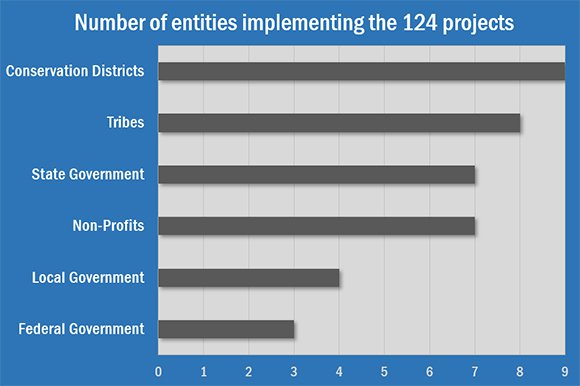Council Approves Habitat Restoration and Hatchery Projects for Funding
On the ground results also point to the need for stable funding to sustain long-term benefits
- April 19, 2022
- Carol Winkel
An array of habitat and hatchery projects in the anadromous zone of the Columbia Basin received approval from Council members in April, completing the final set of projects reviewed for funding through the Council’s fish and wildlife program. The program is the largest regional effort to recover and protect fish and wildlife in the nation, funded by the Bonneville Power Administration.
The Anadromous Fish Habitat and Hatchery Project Review considered 124 projects ranging from a variety of work like hatchery operation and maintenance, fish screen installation, habitat restoration, and their associated monitoring and evaluation activities. These projects, as the others reviewed earlier, are ongoing and implement measures in the Council’s program.
Mark Fritsch, project review and implementation manager, noted the impressive range of accomplishments reported by projects. “This is an important review,” said Fritsch. “Habitat work and hatchery programs are two key mitigation efforts of the program—they represent restoration activities and the latest in fish production techniques, integrated with monitoring and evaluation efforts.”

Annual funding for these projects is approximately $134 million, with a reported total confirmed cost share of approximately $463 million over time. Some of the projects in this group leverages Bonneville’s funding by an impressive 8 to 1.
Approximately 70 percent of the projects in the review focus on habitat work to maintain fish screens, ladders, traps, and research, monitoring and evaluation. And approximately 30 percent of projects focus on hatcheries and artificial production activities.
Maureen Hess, fish and wildlife program analyst, gave an overview of the tangible results. For example, for habitat-focused projects: one project reported over 29,000 acres of habitat protected, restored, and enhanced and over 4,000 acres reconnected in the estuary; a project in the Deschutes subbasin restored function to over 13 miles of stream channel and floodplain habitat; removed irrigation and passage barriers and opened an additional 6 miles of habitat to migrating adult steelhead; some projects work to protect riparian and floodplain habitat on private lands and reported over 20,000 acres of riparian buffers and nearly 1,000 stream miles protected.
Most of the hatchery-focused projects implement the hatchery release programs and operate facilities that serve to mitigate impacts to fish caused by the hydrosystem. Demonstrated results of these projects highlight the successes in preventing extinction of critical fish populations and supporting and maintaining natural production and harvest in a manner consistent with conservation of natural fish populations.
“Equally notable is the level of coordination created through the program,” noted Hess. “The projects are implemented by 38 organizations and governments, with extensive collaboration and coordination within and among projects.”
An important component to the process is the review by the Council’s Independent Scientific Review Panel to ensure that projects are based on sound scientific principles; benefit fish and wildlife; and have clearly defined objectives and outcomes, with provisions for monitoring and evaluating results.
One of the important messages from the review was the need for Bonneville to establish a systematic approach to providing funding for non-recurring maintenance needs and adequate annual preventive maintenance for fish screens, lands, and hatcheries.
Securing a consistent funding stream to support asset management has been complicated by the ongoing issue of flat funding. However, stable, long-term funding is critical to ensuring that the program’s past investments will continue to deliver their intended benefits to fish and wildlife throughout the basin.



